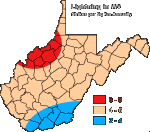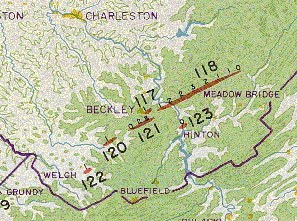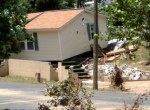West Virginia Severe Weather FAQ
|
In September of 2025, my work is generating the most income it ever has in my career. Yet, I'm being forced to shut down my successul operation, against my will, due to one cause alone: 95% of that revenue is being stolen by piracy and copyright infringement. I've lost more than $1 million to copyright infringement in the last 15 years, and it's finally brought an end to my professional storm chasing operation. Do not be misled by the lies of infringers, anti-copyright activists and organized piracy cartels. This page is a detailed, evidenced account of my battle I had to undertake to just barely stay in business, and eventually could not overcome. It's a problem faced by all of my colleagues and most other creators in the field. |
Before moving to the Midwest, I lived in West Virginia and covered storms there for 17 years. During that time, I covered everything from lightning to floods to winter storms - all over the state. Contrary to what one might first think, the Mountain State is very active with thunderstorms and significant weather events. Here are some answers to common questions I received over the years:
Which areas of WV experience the most storms?
Do WV mountains stop tornadoes and severe weather?
How many tornadoes occur in WV?
Do supercells and large hail happen in WV?
Can you go tornadoes in WV?
Where can I find reports of past severe weather in WV?
Are you safe from lightning in the valleys and 'hollers' of WV?
What aspect of storms presents the biggest danger to West Virginians?
Which areas of WV experience the most storms?
 Lightning strike data collected over the past several years divides our state into three regions of thunderstorm frequency (at right, click map to enlarge). (Source: NLSI)
West Virginia's own 'Lightning Alley' (shaded in red) is located in the Parkersburg area near the Ohio River, and includes the counties of Jackson, Wood, Pleasants, Ritchie, Tyler and Wirt. This region receives an average of 6 to 8 cloud-to-ground strikes per square kilometer every year. By contrast, the region south of Beckley to the Virginia state line (shaded in blue, including parts of McDowell, Mercer, Raleigh, Summers, Greenbrier and Monroe Counties), receives the least amount of lightning- only 2 to 4 strikes per square kilometer per year.
The rest of the state (shaded in orange) averages between 4 to 6 cloud-to-ground lightning strikes per square kilometer annually.
Not in the least bit! West Virginia's tornado incidents are few due to our climate, not because of our mountains. Tornado and/or severe thunderstorm formation is a product of large-scale weather forces that can happen anywhere the conditions are right, and is largely independent of topography.
The climate in the northeastern USA (not only in WV) makes it a rare event for all of the meteorological 'ingredients' needed to form tornadoes to come together. But when those ingredients DO come together, nothing on the ground will stop a tornado from forming - not even West Virginia's highest mountains.
During the 'Super Outbreak' in April of 1974, those 'ingredients' came together in a big way - resulting in an incredible 148 tornadoes touching down in 13 states during a 16-hour time frame. West Virginia was included in the disaster, with several large twisters slicing their way northeast through McDowell, Wyoming, Raleigh, Summers, Fayette, and Greenbrier counties. These tornadoes traversed some of the most rugged terrain in the state, with two of them even crossing the New River Gorge. The map below shows the path of the tornadoes in West Virginia during the 1974 Super Outbreak. The damage paths are denoted by red lines, with the F-scale (intensity) number indicated beside each path:  Source: NOAA Public Affairs Source: NOAA Public Affairs
During a more recent outbreak in the northeastern USA on the afternoon of June 2, 1998, 9 tornadoes touched down in West Virginia, including four in the Kanawha Valley area (including one in Charleston and one in Cabin Creek).
It could be said that the mountains indirectly limit our tornado numbers by helping to maintain our climate. But the weather will sometimes deviate from the typical climate, allowing the right ingredients to come together. When this happens, supercells will develop and the mountains will do nothing to deter any tornadic circulation. An average of two confirmed tornadoes are reported in West Virginia each year. Most mountaineer twisters are weak and brief, and typically are rated no more than F1 on the Fujita intensity scale. However, it is likely that more tornadoes actually touch down in the state and go unreported due to our rugged, remote terrain.
Do supercells and large hail happen in WV?
At least once or twice a year, supercell thunderstorms form in West Virginia or move in from adjactent states. Most of West Virginia's tornadoes happen with these storms. While most of WV's supercells do not produce tornadoes, they can and do produce large hail. I witnessed tennis-ball sized hail (near baseball size) in Sissonville on June 22, 2008. On June 17, 2009, I tracked a rotating supercell from I-79 at Big Otter to Route 19 near Birch River. It developed several wall clouds, and was close to producing a tornado. On June 2, 1998, I was in the supercell storm that produced golf-ball sized hail in Charleston. That storm produced at least 2 tornadoes in the state, one at Apple Grove and another in Kanawha City (just south of Charleston). I have witnessed and covered several other supercell storms over the years, usually in the western half of the state in the lower elevations. Again, if the conditions are right, supercells and even tornadoes can happen anywhere in the state, even crossing the highest mountains and deepest valleys.
Can you go tornadoes in WV?
Considering the fact that only two tornadoes are reported here each year, your odds of seeing one in West Virginia are very slim. The proposition of purposely seeking them out is a highly impractical one. Even if Tornado Alley was centered over our state, the terrain makes observing and filming very difficult. Our road network is sparse and curvy, with only a few Interstates and 4-lane highways where fast travel is possible. And since most roads in WV follow valleys rather than ridges, the view of the sky is always limited, making visual sightings and identifications of tornadoes and storm structure difficult if not impossible in most cases.
When I chased in West Virginia, I would typically intercept storms only where they crossed major four-lane highways and interstates. Those roads allow for faster travel, and have a very wide right-of-way which affords a better view of the skies. On two-lane roads, your speed is limited by the sharp curves, and there are very few openings in the trees to maintain a visual on what storms are doing. Major river valleys also have better sky visibility, though these are virtually non-existent aside from the Kanawha and Ohio Rivers. There is also the rare ridgetop road that will have an occasional vista view, but unless you know where your local spots are, it's not practical to expect to find one in any given area. 
Where can I find reports of past severe weather in WV?
Are you safe from lightning in the valleys and 'hollows' of WV?
Lightning will strike anywhere, including in valleys, 'hollows', and on mountainsides as well as mountaintops and ridges. See Lightning Myths for more information.  Without a doubt, flash flooding is the biggest threat from thunderstorms that West Virginians face. Our mountainous topography quickly funnels runoff from heavy rains into the valleys, where devastating flooding can occur. Every year, many locations in the state are hit by flash flooding that results from as little as 2 inches of rain. Rockslides, mudslides and tree falls are also a related danger on steep slopes during thunderstorms.
 About the Author: Dan Robinson has been a storm chaser, photographer and cameraman for 33 years. His career has involved traveling around the country covering the most extreme weather on the planet including tornadoes, hurricanes, lightning, floods and winter storms. Dan has been extensively published in newspapers, magazines, web articles and more, and has both supplied footage for and appeared in numerous television productions and newscasts. He has also been involved in the research community, providing material for published scientific journal papers on tornadoes and lightning. |
GO: Home | Storm Chase Logs | Photography | Extreme Weather Library | Stock Footage | Blog
Featured Weather Library Article:
|